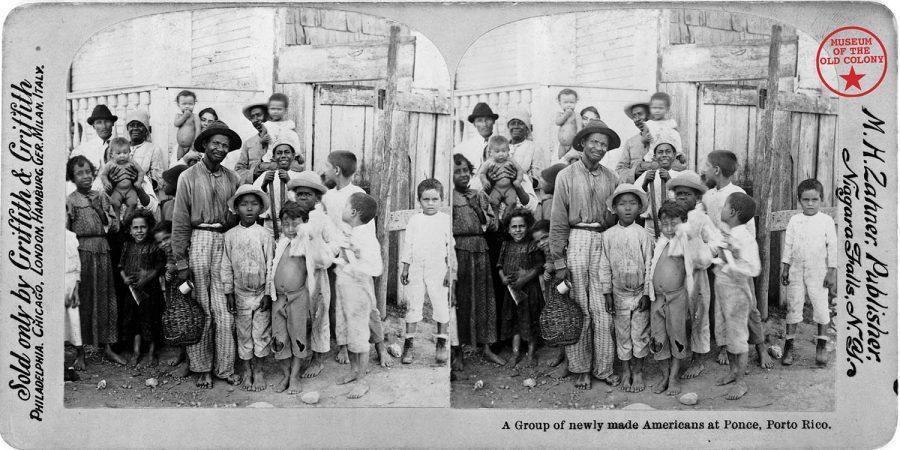Identity Politics Ring True at KJCC
Library of Congress, Stereo-Card by M. H. Zahner
A group of newly made Americans at Ponce, Puerto Rico.
February 6, 2017
When people discuss what constitutes the territory of the United States, they often forget the “unincorporated territory” of Puerto Rico, even though it has been under the U.S. government since 1899. Given the current political climate, where American identity has been called into question, Puerto Ricans’ citizenship can be challenging to comprehend. Their island is a part of our country and subject to federal laws while at the same time it is also considered a “free associated state” — meaning that Puerto Ricans cannot directly vote in presidential elections due to provisions of the Electoral College. Since the United States invaded the once-Spanish territory, its residents’ in-between status has created a culture built upon political and economic hegemony of remote lands.
Puerto Rican artist and photographer Pablo Delano explores this ambiguity in his new exhibition “The Museum of the Old Colony” at NYU’s King Juan Carlos I Center, which is dedicated to the interdisciplinary study of modern Spain and the Spanish-speaking world. Delano uses a combination of still and moving images collected over the past 20 years to investigate the island’s colonial history and its nebulous cultural impact. The images come from books and magazines of U.S. propaganda that validate the United States’ colonial mission.
“The text is often condescending,” Delano said. “If you read one of these captions, they would generalize by saying that under the Spaniards, everything was very bad and [that] now, under the U.S. flag, ‘we are going to make everything better for this poor, ignorant, unfortunate people,’ almost as if they were missionaries.”
Delano was born and raised in Puerto Rico and lived there until he was 18. He moved to the continental United States to study at Philadelphia’s Tyler School of Art and Yale University. Today, he is a professor of Fine Arts at Trinity College. Delano’s roots have guided much of his work — a trip to the former British colonies Trinidad and Tobago initiated his fascination with the political situation of his homeland.
“It was really inspiring for me to see how this small country was establishing itself as a free country and leaving the colonial days behind to start in a new mission, to try and see how it would create itself as a nation,” Delano said. “One of the things that really struck me was that the government had invested strongly in the arts and in diversity as a positive thing — as a means to move forward.”
For the artist, working on this project resulted in a great deal of personal reflection regarding racism, the nuances of his identity and current ideological discourses circulating in the United States. He hopes the exhibit will prompt the same sort of reflection from its visitors.
“You can see that the tone [imprinted in the documents] changes along time, the way that ideas are expressed becomes more politically correct and liberal-minded, but the attitude now is still very similar and hasn’t changed very much,” Delano said. “To the question if people are today less racist, I don’t know.”
“The Museum of the Old Colony” will remain on view through March 16. On Feb. 16, the center will host a roundtable discussion with the artist to discuss politics of representation in photography, the cultural impact of colonialism and the image repertoires and national imaginaries of Puerto Rico.
A version of this article appeared in the Monday, Feb. 6 print edition. Email Maria Jose Lavandera at [email protected].
















































































































































Ana Dopico • Feb 7, 2017 at 3:29 pm
As the DIrector of the KJCC, and as the co-originator of this exhibition I am very glad to see it covered by in the paper and by Lavandera’s piece. Glad to see it covered.
But I have to note that your headline about identity politics really misrepresents this exhibit.
“Identity Politics” is a word which is often used as code to describe or disqualify identitarian claims to rights.
This exhibition is NOT about identity politics, and NOT about identity but about the living discourses and images of U.S. colonialism in Puerto Rico.
It is not about how Puerto Ricans claim their identity or claim political rights based on their identity. It is about the way images and language aided that suspension and gross distortion of rights and any possible identity by the operations of colonialism.
I suggest your headlines editor walk over to the KJCC to see the exhibit before using a loaded and misleading term to describe its content. I would be happy to welcome them and show them around.